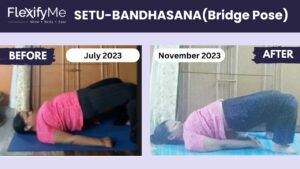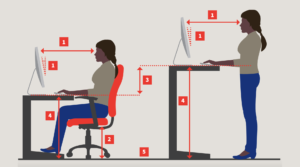Chatting About Keeping You Healthy at Work: Tackling Musculoskeletal Disorders
Alright, let’s get into the heart of making our workspaces better for our health. You know, after all that initial homework—crunching numbers, gathering insights—we’re now stepping into the action zone. We’re zeroing in on these things called Work-Related Musculoskeletal Disorders (WMSDs), and trust me, it’s less jargon-y than it sounds. Essentially, it’s about tackling those aches and pains that sneak up on us at work.
Before we dive into fixing things, it’s like we’re setting up a game plan to check if our strategies are hitting the mark. Think of it as laying out breadcrumbs to ensure we’re on the right track in making our workplaces healthier and keeping those pesky WMSDs at bay.
Let’s simplify MSDs a bit. Imagine your body as this amazing, intricate machine where everything’s interconnected—muscles, bones, nerves, you name it. When we throw in some not-so-great work conditions, like repetitive tasks or awkward postures, it can throw a wrench in the works, leading to these disorders. Remember how back in the ’90s, experts at NIOSH pointed out that certain work habits could lead us down this path? That’s the kind of stuff we’re looking to sidestep.
Now, on to the juicy part—symptoms. Ever felt a weird twinge or stiffness during your workday? Maybe your wrist gets all tingly after hours of typing, or your back starts complaining after a day of heavy lifting. Those signals are your body’s way of waving a red flag, saying, “Hey, pay attention to me!”
But don’t worry, it’s not all doom and gloom. Addressing MSDs isn’t just about medical jargon or complex treatments. It’s about practical, everyday actions—like adjusting your chair height, learning some cool stretching exercises, or even switching up your routine to give your body a break.
And because we all love staying ahead of the curve, we’re spicing up this section with the latest findings and relatable examples. It’s all about giving you the tools and knowledge to be proactive about your health at work.
Diving Deeper Into Musculoskeletal Disorders – Beyond Just a Bad Chair
Alright, we’ve chatted about what WMSDs are and how they can be a real pain (literally), but let’s zoom in a bit more. We’ve all heard of the usual suspects like back pain or carpal tunnel syndrome, but there’s a whole lineup of these disorders that can cramp our work style.
1. Carpal Tunnel Syndrome: The Office Worker’s Nemesis
First up, let’s talk about carpal tunnel syndrome (CTS). Picture this: you’re hammering away on your keyboard, day in and day out, and then you start feeling this annoying numbness or tingling in your hand and wrist. That’s CTS making its grand entrance. It’s like your hand’s personal SOS signal, thanks to the median nerve in your wrist getting all squeezed and irritated.

Now, the U.S. Department of Labor wasn’t just making up numbers when they said loads of folks get hit with CTS, especially in our keyboard-crazy world. But hey, it’s not all about donning wrist braces or heading straight to surgery. There are simpler ways to fight back, like tweaking your workstation or mastering the art of ergonomic typing.
2. Back Injuries: Not Just About Heavy Lifting
Moving on to back injuries—oh boy, do they get a bad rap. But it’s not just about lifting heavy stuff. Even sitting all day or having a poor posture (yeah, slouching, I’m looking at you) can do a number on your back. It’s one of the top reasons folks end up at the doctor’s, and trust me, chronic back pain is no joke.
But here’s the kicker: most of these back woes can be dodged with some smart moves. Think ergonomic chairs, standing desks, or just getting up and moving around regularly. Your back will thank you.
3. Arthritis: It’s Not Just Your Grandma’s Problem
Then there’s arthritis, and no, it’s not just something older people deal with. Many young guns in the workforce face it too, especially with jobs that put extra stress on the joints. It’s all about inflammation in your joints, leading to pain and stiffness, and it can be a real drag, especially if your job involves a lot of physical activity.
But don’t fret—there are ways to make work life better even with arthritis. Ergonomic tools, flexible work arrangements, and staying active can all help keep those joints happier.
Winning Tactics Against Workplace Aches and Pains – Your Action Plan
Alright, we’ve talked our heads off about those bothersome musculoskeletal disorders, but what’s the game plan to tackle them head-on? Let’s dive into some real-deal strategies that can turn your workspace into a no-pain zone.
1. Workspace Makeover: Your Personal Ergo-Revamp
Think of engineering controls like giving your workspace a personal makeover. It’s about getting that desk or chair that feels just right or introducing tools that don’t make you twist and turn awkwardly. Imagine having a desk that rises with a push of a button, letting you stand and stretch those legs. Or what about those ergonomic mouse and keyboards that feel like a soft pillow for your hands? It’s all about making your space work for you, not against you.
2. Smarter Workflows: It’s All About the Breaks and Shifts
Now, onto the brainy stuff—administrative controls. It’s like rewriting the rulebook for a healthier workday. Let’s mix things up with job rotation, so you’re not stuck in a repetitive motion loop. And why not champion the cause for more breaks? Get up, stretch, stroll—make it a part of the day. It’s like hitting the refresh button on your brain and body, keeping those muscles happy and minds sharp.
3. Gear Up: Your Mini Shield Against Strain
PPE might not be the most glamorous getup, but it’s your mini shield at work. Whether it’s wrist supports that keep carpal tunnel at bay or knee pads for those who are always on the move, it’s about having that extra layer of defense. Think of it as your personal health insurance, right there in the trenches with you.
4. Power-Up With Knowledge: Your Secret Weapon
Finally, don’t underestimate the power of good old knowledge. Being in the know with proper training can turn you into a workplace wellness warrior. It’s about understanding the whys and hows—why that posture matters, how to lift correctly, or what signs to watch for when your body’s waving a red flag. Knowledge isn’t just power; it’s your secret weapon against those sneaky musculoskeletal foes.
Beyond the Basics: Deep Dives and Pro Tips for Musculoskeletal Wellness at Work
So, we’ve got our battle strategies against those pesky musculoskeletal disorders, but why stop there? Let’s go a step further and become pros at keeping our workdays pain-free and productive. Think of this as your advanced course in workplace wellness, sprinkled with some pro tips and deep dives.
1. The Ergonomic Detective: Uncover Hidden Culprits in Your Workspace
Ever feel like something’s just not right at your desk or workstation? Time to don your detective hat and get to the bottom of it. Look beyond the obvious and spot those hidden ergonomic pitfalls—like that slightly off monitor height or the chair that’s just a tad too low. Fine-tuning these details can make a world of difference, turning your workspace into a comfort zone that keeps those aches at bay.
2. Tech to the Rescue: Gadgets and Apps That Have Your Back (Literally)
In our digital age, there’s a gadget or app for almost everything, and workplace health is no exception. Explore tools that remind you to take a break, stretch, or even correct your posture. Think posture sensors that nudge you when you slouch or apps that guide you through mini-exercises right at your desk. It’s like having a personal wellness coach, right there in your pocket or on your desk.
3. Build Your Musculoskeletal IQ: Knowledge That Empowers
While we’re all about practical tips, diving a bit into the ‘why’ and ‘how’ can empower you even more. Understanding the mechanics of musculoskeletal health can turn you from a participant to a champion in workplace wellness. Engage with webinars, workshops, or even short courses that deepen your understanding of body mechanics and preventive strategies. It’s like leveling up in your health game.
4. Community Power: Share, Learn, and Grow Together
Lastly, remember you’re not in this alone. There’s power in community. Share your insights, learn from others, and build a network of wellness allies at work. Whether it’s forming a lunchtime walking group, sharing ergonomic tips, or even starting a wellness newsletter, it’s all about creating a culture of health and support.
1. Bernard BP, editor. U.S. Department of Health and Human Services, Centers for Disease control and Prevention, National Institute of Occupational Safety and Health. Musculoskeletal disorders and workplace factors: a critical review of epidemiologic evidence for work-related musculoskeletal disorders of the neck, upper extremity, and lower back. July 1997. DHHS (NIOSH) Publication No. 97-141.
2. NIOSH workers health chartbook 2004. NIOSH Publication No. 2004-146. Washington, D.C.
3. National Research Council and the Institute of Medicine (2001). Musculoskeletal disorders and the workplace: low back and upper extremities. Panel on Musculoskeletal Disorders and the Workplace. Commission on Behavioral and Social Sciences and Education. Washington, DC: National Academy Press.
4. Carpal tunnel syndrome (CTS). In: Chapter 2: Fatal and nonfatal injuries, and selected illnesses and conditions. In: Worker health chartbook 2004. NIOSH publication no. 2004-146. Washington, D.C.
5. Evidence Report/Technology Assessment: Number 62 – Diagnosis and Treatment of Worker-Related Musculoskeletal Disorders of the Upper Extremity. 2004.
6. Primary Care Interventions to Prevent Low Back Pain in Adults. U.S. Preventive Services Task Force. 2004.
7. Back, including spine and spinal cord. In: Chapter 2: Fatal and nonfatal injuries, and selected illnesses and conditions. In: Worker health chartbook 2004. NIOSH publication no. 2004-146. Washington, D.C.
8. Brault MW, Hootman J, Helmick CG, Theis KA, Armour BS. Prevalence and Most Common Causes of Disability Among Adults — United States, 2005. MMWR 2009; 58(16):421-426.
9. Hootman J, Bolen J, Helmick C, Langmaid G. Prevalence of doctor-diagnosed arthritis and arthritis-attributable activity limitation—United States, 2003-2005. MMWR 2006;55(40):1089–1092.
10. Helmick CG, Felson DT, Lawrence RC, Gabriel S, Hirsch R, Kwoh CK, Liang MH, Kremers HM, Mayes MD, Merkel PA, Pillemer SR, Reveille JD, Stone JH. Estimates of the prevalence of arthritis and other rheumatic conditions in the United States. Part I. Arthritis and Rheumatism 2008;58(1):15-25.
11. Lawrence RC, Felson DT, Helmick CG, Arnold LM, Choi H, Deyo RA Gabriel S, Hirsch R, Hochberg MC, Hunder GG, Jordan JM, Katz JN, Kremers HM, Wolfe F. Estimates of the prevalence of arthritis and other rheumatic conditions in the United States. Part II. Arthritis and Rheumatism 2008;58(1):26-35.
12. Felson DT, Zhang Y. An update on the epidemiology of knee and hip osteoarthritis with a view to prevention. Arthritis Rheum 1998; 41:1343-1355.
13. Rossignol M, Leclerc A, Allaert FA, Rozenberg S, Valat JP, Avouac B, Coste P, Litvak K, Hilliquin P. Primary osteoarthritis of the hip, knee, and hand in relation to occupational exposure. Occup Environ Med 2005; 62:772-777.
14. Yelin E, Murphy L, Cisternas M, Foreman A, Pasta D, Helmick C. Medical care expenditures and earnings losses among persons with arthritis and other rheumatic conditions in 2003, and comparisons to 1997. Arthritis and Rheumatism 2007;56(5):1397-1407.
15. Theis KA, Hootman JM, Helmick CG, Murphy LM, Bolen J, Langmaid G, Jones GC. State-specific prevalence of arthritis-attributable work limitation—United States, 2003. MMWR 2007; 56: 1045-1049.
16. National Business Group on Health. Arthritis’ effect on the workforce.
17. U.S. Department of Defense: Ergonomics Tech Guide 220: Booklet I, General Program Management.


